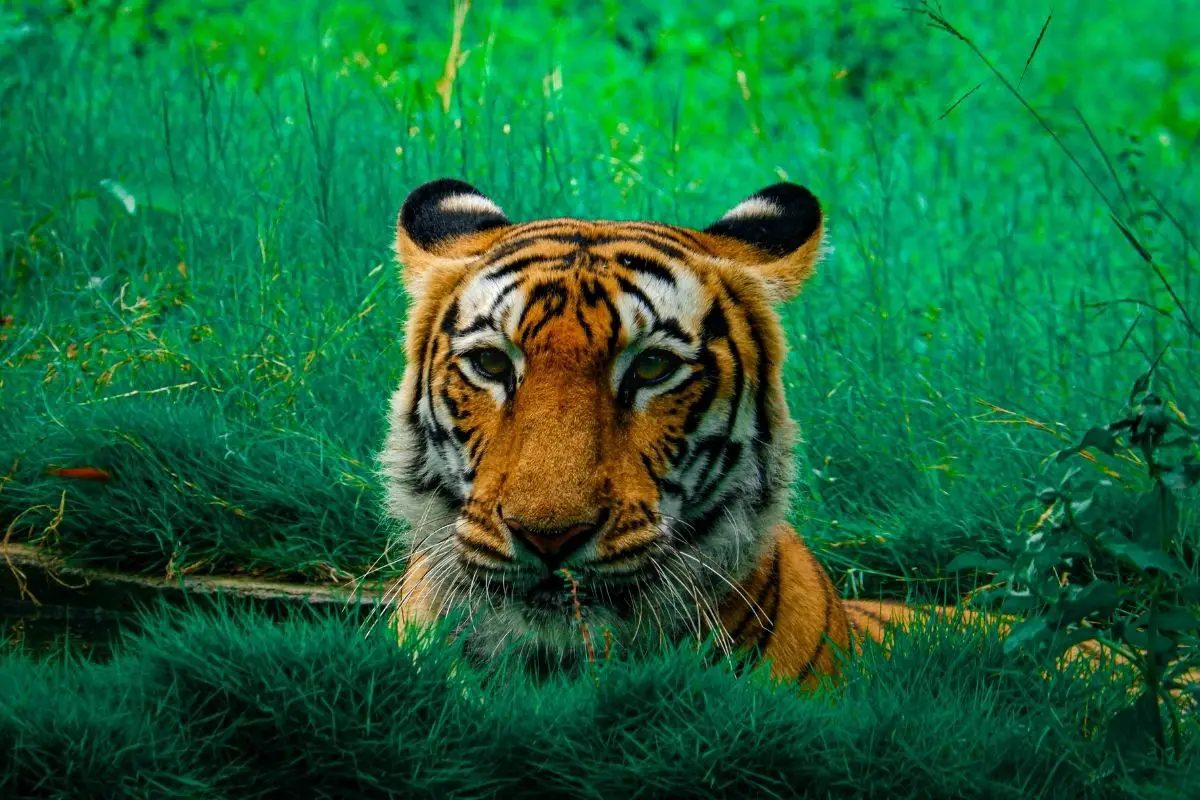Tigers are apex predators, meaning that their diet is broad and primarily consists of other animals. Tigers are not picky eaters, and will eat whatever is available to them.
This includes boars, bears, buffaloes, deer, gaur (an Indian bison), horses, antelopes, goats, tapirs, wild dogs, wild pigs, wild cattle, and young elephants.

If larger prey isn’t available, tigers will also hunt smaller animals such as birds, frogs, hares, rodents, fishes (depending on their habitat), snakes, lizards, and – you guessed it – monkeys!
If a tiger is really hungry, it will also sometimes eat grass and berries in order to sustain itself and regulate its digestive system.
Although tigers are decreasing in the wild, different species of tiger live all over Southeast Asia, and this means that tigers have varying diets depending on which region they live in.
No matter where tigers live however, their favorite things to eat are medium to large animals, such as deer, pigs, rhinos, and even elephant calves. But how available this prey is to tigers will depend on the location.
So which tigers eat monkeys and which tigers don’t? And how does the diet of tigers in captivity differ from the diet of tigers in the wild? We’ll answer all of these questions below, as well as take a closer look at the eating habits of tigers.
Sumatran Tigers
Sumatran tigers are so named as they hail from the Sumatran Islands, and in 2008 were declared by the IUCN as a critically endangered species.
Sumatran tigers eat crocodiles, deer, fishes, birds, wild pigs, and monkeys. They patiently stalk their prey for as long as one and a half hours before they attack.
They also have a fascinating habit of covering the carcass they’ve just devoured with grass, hiding the carcass from other predators so they can continue to feed from it later.
Bengal Tigers
Bengal tigers can be found in Bangladesh, Bhutan, India, and Nepal and like to hunt large mammals like deer, serow and tarin (goats), and water buffalo.
They also regularly hunt wild boar, muntjac deer, and grey langurs which are monkeys. Bengal tigers also occasionally prey on smaller creatures like hares, peafowl, and porcupines.
Humans often come into contact with the habitats of Bengal tigers so they will also eat domestic cattle, which results in them getting into encounters with farmers who are naturally angered by the tigers eating their livestock.
This often leads to farmers killing tigers, which is a factor in the decline of Bengal tigers in the wild.
Siberian Tigers
Found in the far east of Russia, small areas of northern China, and occasionally North Korea, Siberian tigers eat wild boar, elk, Manchurian red deer, long-tailed goral (a bovine that looks like a large goat), lynx and bears.
They will also eat hare, rabbits, pika (a small rodent that looks like a large mouse), and occasionally even salmon.
South China Tiger
The South China Tiger is sadly considered to be practically extinct in the wild, but they would eat hog deer, muntjac deer, wild boar, and the gray langur monkey if they are able to catch them.
South China tigers would also eat smaller animals such as hares, peacocks, and porcupines.
Malaysian Tiger
The Malaysian tiger mainly eats bearded pigs, muntjac deer, sambar, wild boar, serow (these are large mammals that resemble both an antelope and a goat), and small sun bears. They will also occasionally eat elephant calves that are small, weak, or injured.
Do Tigers Eat Chimpanzees?

Chimpanzees try very hard to avoid being attacked by predators like tigers by staying well away from the forest floor.
However, when chimpanzees need to leave the treetops for water, food, or to mate then tigers will most likely strike if they encounter a chimpanzee.
Do Tigers Have To Eat Every Day?
Depending on the hunting conditions, tigers can consume up to 10-20 lbs of prey in one day. For context, that’s around 4-7% of their body weight! However, when their prey is scarce, they can go without eating meat for days.
Tigers’ carnivorous nature is what is responsible for their ability to eat so much meat in a single day. But when food is scarce they can go for two weeks without eating meat, and when conditions improve they can eat up to 75 lbs of meat in a single day!
Do Tigers Eat Humans?
Yes, tigers can absolutely eat humans. Throughout history there have been incidents where big cats like tigers have attacked humans and seen them as prey.
While attacks like these are fewer as we become more educated about the dangers of straying too close to predators, and the population of tigers sadly decreases, we still hear news stories about tigers attacking humans when hungry or threatened.
These incidents usually occur when humans wander into tigers’ natural habitats, or when tigers wander into human habitats looking for food, and this is usually due to the fact that the tiger has experienced the loss of their habitat.
What Do Tigers Eat When In Captivity?
Naturally, tigers in captivity don’t have to hunt for their prey like tigers in the wild do. Instead, zookeepers ensure that captive tigers are fed every day, and that the meat they are fed has all the minerals and vitamins the tiger needs.
Sometimes the meat will also have medication in it, if the tiger has health problems that need to be treated.
Tigers in captivity will usually eat around 10-15 kg of meat per day, and they usually eat beef, goat, chicken, horse, rabbit, and sometimes even donkeys, water buffalo, and kangaroos!
Ideally, the bones and the hide will still be present to mimic how tigers would feed on their prey in the wild.
Final Thoughts
It is safe to say that tigers have a varied diet in the wild, and that includes monkeys!
But although tigers have a wide and versatile diet, their favorite prey seems to be mammals like deer and antelope as they are very common in their natural habitat and are a more substantial meal than monkeys.
- Bengal Cat vs Wild Bengal Tiger: Complete Comparison 2025 - October 31, 2025
- Complete Wild Cat Spotting Guide for Hikers 2025 - October 31, 2025
- Lynx vs Bobcat: Complete Field Identification Guide 2025 - October 30, 2025








